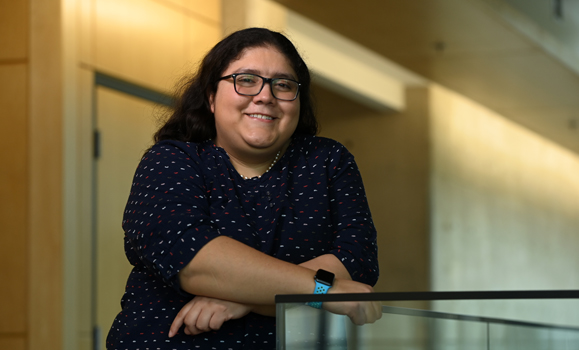When we picture ourselves drawing, we imagine using a pen and paper to bring our visions to life.
For Dalhousie’s Mayra Donaji Barrera Machuca, analyzing drawings goes far beyond typical pen-and-paper sketches. An assistant professor in the Faculty of Computer Science, Dr. Barrera Machuca’s research focuses on how users utilize immersive three-dimensional (3D) sketching in virtual reality (VR).
“My research has a focus on helping people to sketch more accurately when working inside a 3D virtual environment,” Dr. Barrera Machuca explains. “When you’re sketching there are two types of tasks, creating straight precise lines and creating shapes like cubes. I focus on the shapes because I find it fascinating that most people can draw 2D [two-dimensional] cubes but struggle with 3D.”
In 2015, Dr. Barrera Machuca attended Simon Fraser University for her PhD studies and worked with supervisor, Wolfgang Stuerzlinger, on her dissertation. This research earned her the 2021 Visualization and Graphics Technical Committee’s (VGTC) Virtual Reality Best Dissertation Award. She received the award on March 13 at the IEEE VR Conference.
This award is presented each year to the author of the most outstanding PhD dissertation in the broad areas of virtual and augmented reality.

Related reading: Dal receives more than $3.7 million for equipment and infrastructure
The road to research
Before joining Dalhousie, Dr. Barrera Machuca earned a Bachelor of Arts in Animation and Digital Art from Tecnológico de Monterrey in Mexico City. It wasn’t until she moved to Canada that she realized the impact computer science has on all disciplines and the potential from an animation and digital-art perspective. Her unexpected journey led her to Dalhousie and the Faculty of Computer Science as an assistant professor in 2021.
While working on her dissertation, “Towards More Accurate Immersive 3D Sketching,” Dr. Barrera Machuca had two goals which resulted in four different projects. The first goal was to learn more about the reasonings behind reduced accuracy of 3D sketches compared to 2D ones. The second was to develop new user interfaces that help beginner users draw more accurately while using VR.
“I have many different projects that involve VR sketching,” she says. “The first part of my research was studying how people sketch and to understand what people do before sketching. The second part was analyzing the hand positioning in space, the third was planning how you’re going to move your hand, and the final was reviewing the set of visual guides.”
Ultimately, her research projects have resulted in a better understanding of how people think and react while inside a 3D virtual environment, making VR technology more accessible and easier to use.
For the general public, this means using VR applications will be less frustrating and time consuming as the user interface (UI) will adapt to our abilities. This will allow both people and businesses to do more, whether that’s experiencing VR applications through videos games, educating and learning course materials, using social media platforms, or even executing work tasks.
“One day, I hope my work has an impact outside academia and helps companies working in the VR space to design better user interfaces,” she says.
Related reading: Going boldly: Five Dal scholars receive $1.1 million to move in ambitious new research directions

